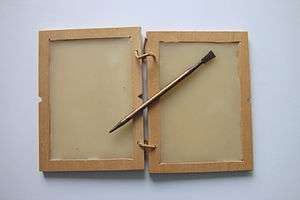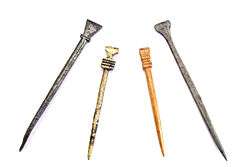Stylus

A stylus, plural styli or styluses,[1] is a writing utensil, or a small tool for some other form of marking or shaping, for example in pottery. It can also be a computer accessory that is used to assist in navigating or providing more precision when using touchscreens. It usually refers to a narrow elongated staff, similar to a modern ballpoint pen. Many styluses are heavily curved to be held more easily. Another widely used writing tool is the stylus used by blind users in conjunction with the slate for punching out the dots in Braille.[2]

Styluses were first used by the ancient Mesopotamians in order to write in cuneiform. Egyptians (Middle Kingdom) and the Minoans of Crete (Linear A and Cretan Hieroglyphic) made styluses in various materials: reeds that grew on the sides of the Tigris and Euphrates rivers and in marshes and down to Egypt where the Egyptians used styluses from sliced reeds with sharp points; bone and metal styluses were also used. Cuneiform was entirely based on the "wedge-shaped" mark that the end of a cut reed made when pushed into a clay tablet; from Latin cuneus = wedge. The linear writings of Crete in the first half of the second millennium BC which were made on clay tablets that were left to dry in the sun until they became "leather" hard before being incised by the stylus. The linear nature of the writing was also dictated by the use of the stylus.
In Western Europe styluses were widely used until the late Middle Ages. For learning purposes the stylus was gradually replaced by a writing slate. From the mid-14th century improved water-powered paper mills produced large and cheap quantities of paper and the wax tablet and stylus disappeared completely from daily life.
Etymology

The word "stylus" (along with the word "style") comes from the Latin word stilus meaning: "a stake; a pointed instrument, used by the Romans, for writing upon wax tablets,"[3] which derives from the Greek word στῦλος meaning "pillar" and "stile for writing on waxed tablets."[4] A different suggestion is that the word does not derive from the Greek word "στῦλος", but that it has a common root with the Greek verb "στίζω" (meaning "mark"). According to the 1875 London Dictionary of Greek & Roman Antiquities a Stylus is "an object tapering like an architectural column; a metal instrument resembling a pencil in size and shape, used for writing or recording impressions upon waxed tablets. It signifies:
"An iron instrument (Ov. Met. IX.521; Martial, XIV.21), resembling a pencil in size and shape, used for writing upon waxed tablets (Plaut. Bacch. IV.4.63; Plin. H.N. XXXIV.14). At one end it was sharpened to a point for scratching the characters upon the wax (Quintil. i.1 §27), while the other end being flat and circular served to render the surface of the tablets smooth again, and so to obliterate what had been written. Thus, vertere stilum means to erase, and hence to correct, as in the well-known precept saepe stilum vertas (Hor. Sat. 1.10.72; Cic. Verr. II.41)."
There exists minor controversy about the correct pluralization of "stylus". Some assert that "stylus" is a direct loanword from Latin and should be pluralised as "styli". However, "stylus" is an English word based on the Latin word "stilus", and is more appropriately pluralised in English as "styluses". Occasionally the pluralisation "stylii" is seen.
Use in arts
Styluses are still used in various arts and crafts. Example situations: rubbing off dry transfer letters, tracing designs onto a new surface with carbon paper, and hand embossing. Styluses are also used to engrave into materials like metal or clay.
Styluses are used to make dots as found in folk art and Mexican pottery artifacts. Oaxaca dot art is created using styluses.
Use in music recording and reproduction
In the sound recording industry, a stylus is a phonograph or gramophone needle used to play back sound on gramophone records, as well as to record the sound indentations on the master record.
Several technologies were used to record the sounds, beginning with wax cylinders, almost half a century before the invention of the magnetic cartridge. Nowadays mostly vinyl records are used. When playing the record, the stylus is placed in the grooves of the record. By then spinning the record, the stylus start to vibrate caused by the shape of the grooves. These vibrations are then converted by the cartridge. The harder the material used for the record, the harder the stylus has to be in order to increase the quality of the sound and to decrease the wear of the needle.[5] For shellac records, a disposable stylus softer than the record was generally preferred for preservation of the recording. The styluses for playing vinyl records are made out of Sapphire or diamond. There are two common types of stylus: elliptical and spherical. Each contacts the groove differently than the other; the elliptical stylus allows for more groove contact, which increases fidelity, while the spherical stylus makes less contact with the groove, which yields a more sensitive stylus.
Smartphones and computing
Modern day devices, such as phones, can often be used with a stylus to accurately navigate through menus, send messages etc. Today, the term stylus often refers to an input tool usually used with touchscreen-enabled devices, such as Tablet PCs, to accurately navigate interface elements, send messages, etc. This also prevents smearing the screen with oils from one's fingers. Styluses may also be used for handwriting; or for drawing using graphics tablets.
Many new phones have a built-in stylus which tucks in behind the back cover. Some styluses may extend and contract into small, pen-like cylinders, which are easy to put away.
Styluses come in both passive and active versions. A passive or capacitive stylus is a stylus that acts just like a finger when touching a device screen. There is no electronic communication between a passive stylus and a device. The device cannot tell the difference between a finger and a passive stylus.
An active stylus includes electronic components that communicate with the touchscreen controller on a device. Active pens are typically used for note taking, on-screen drawing/painting, and electronic document annotation. As before, the stylus is pointed or rounded at one end and is made to fit in the grip of a hand comfortably. These styluses can be found in many different styles.
Palm Rejection: Since many modern tablets make use of multi-touch recognition, some stylus and app manufactures have created palm rejection technologies into their products. This works to turn off the multi-touch feature allowing the palm to rest on the tablet while still recognizing the stylus.
Haptic Stylus: Other than the types above, a haptic stylus is a stylus that simulates the realistic physical sensations on digital surfaces (e.g., tablet computer, smart phone etc.) which can be felt in handwriting tasks on paper. The sensation is sometimes enhanced by the combination of auditory and tactile illusions, such as RealPen.[6]
Scientific instruments
A stylus is also an instrument used to scribe a recording into smoked foil or glass. In various scientific instruments this method may be employed instead of a pen for recording as it has the advantage of being able to operate over a wide temperature range, does not clog or dry prematurely, and has very small friction in comparison to other methods. These characteristics were useful in certain types of early seismographs and in recording barographs that were once used to verify sailplane records. The styluses used in scanning tunneling microscopes have only a single atom at the tip; these are effectively the sharpest styluses possible.
See also
| Look up stylus in Wiktionary, the free dictionary. |
| Wikimedia Commons has media related to stylus. |
References
- ↑ "Stylus - Define Stylus at Dictionary.com". Dictionary.com.
- ↑ "What is Braille?" (web). American Foundation for the Blind. Retrieved 2008-04-02.
- ↑ ND.edu, University of Notre Dame online latin dictionary
- ↑ perseus.tufts.edu, στῦλος at Liddell & Scott
- ↑ "Why are hard materials like diamond being used for turntable stylus' - Bestrecordplayer.net". Bestrecordplayer.net.
- ↑ RealPen
Ruby Ball for stylus